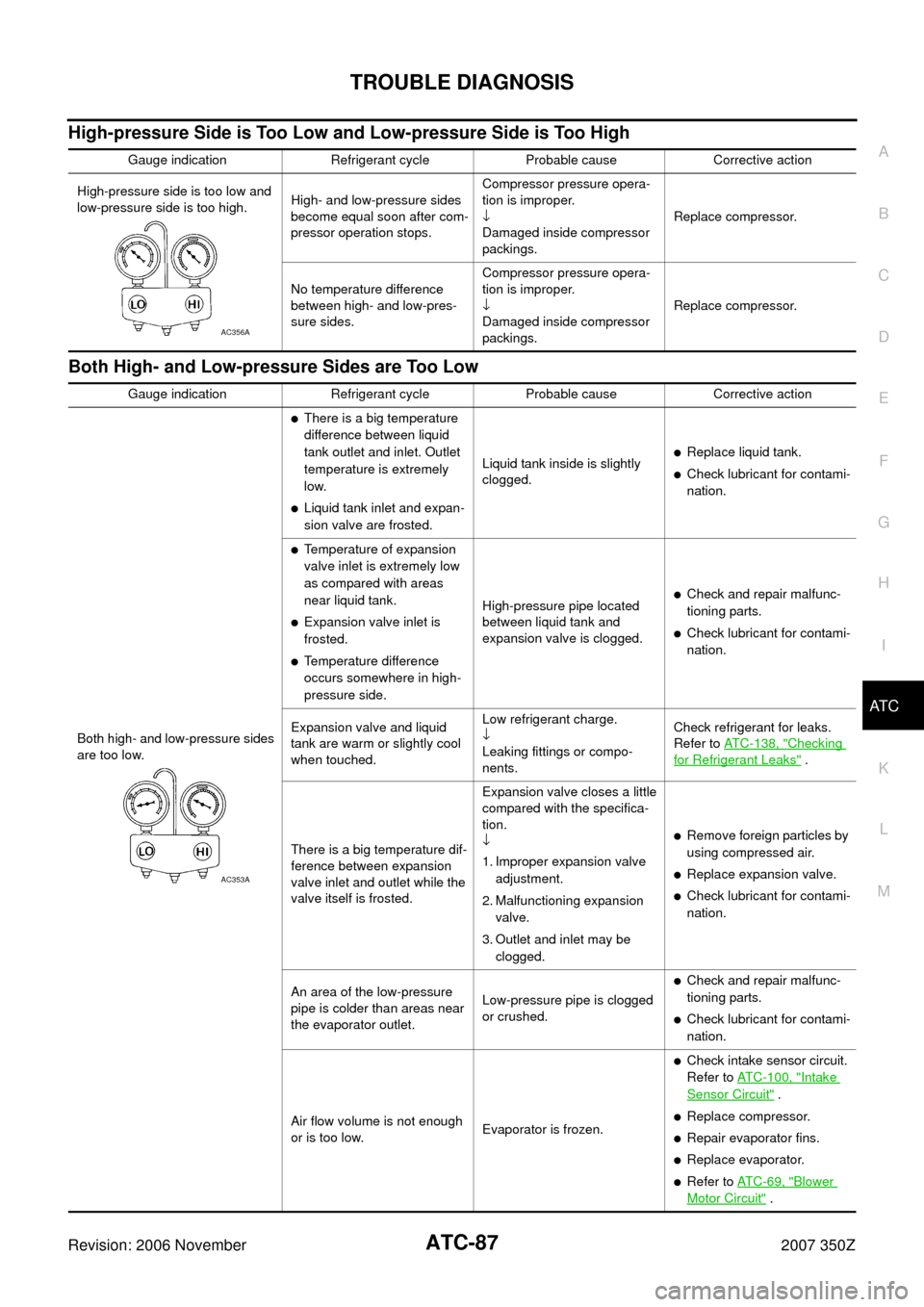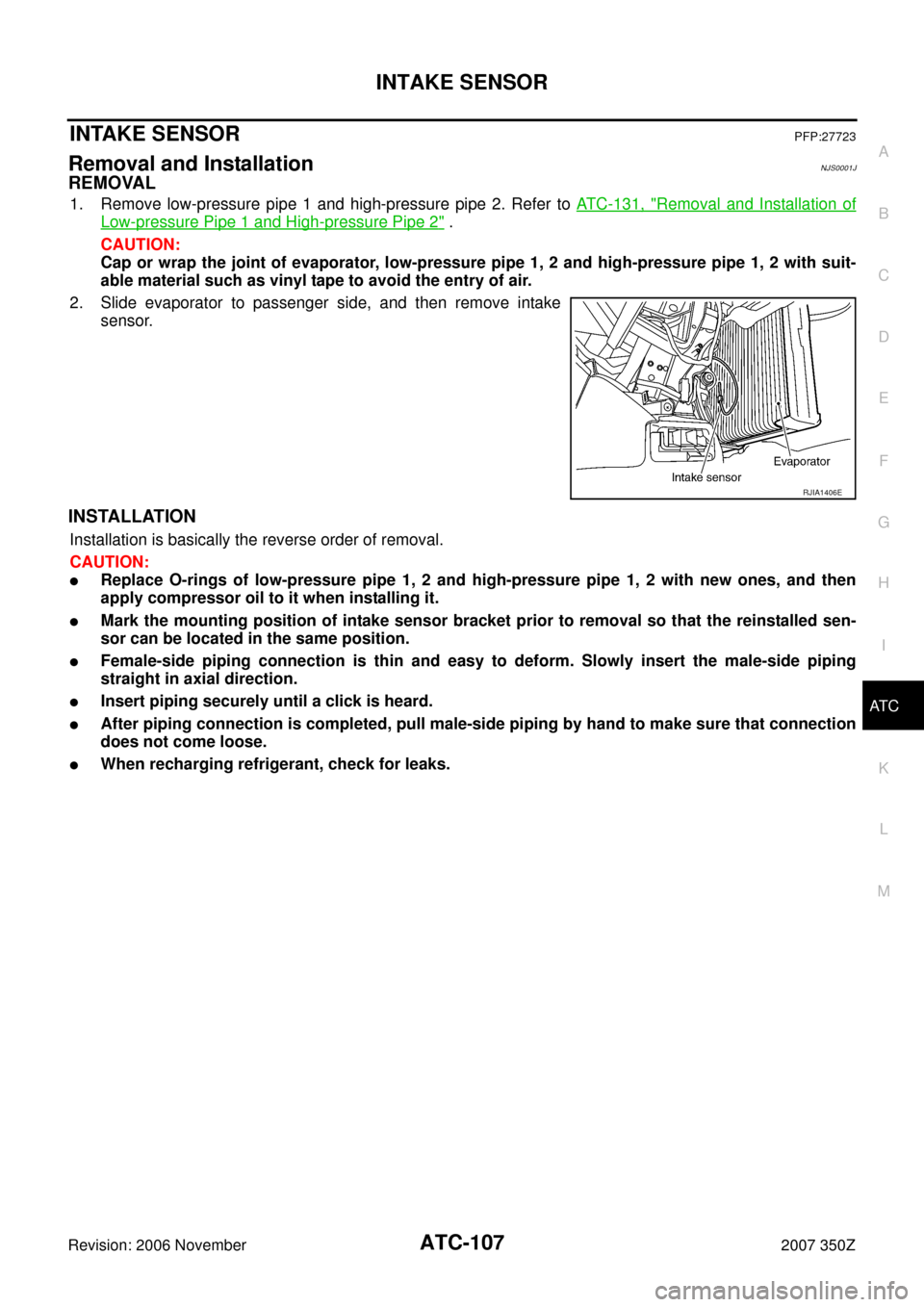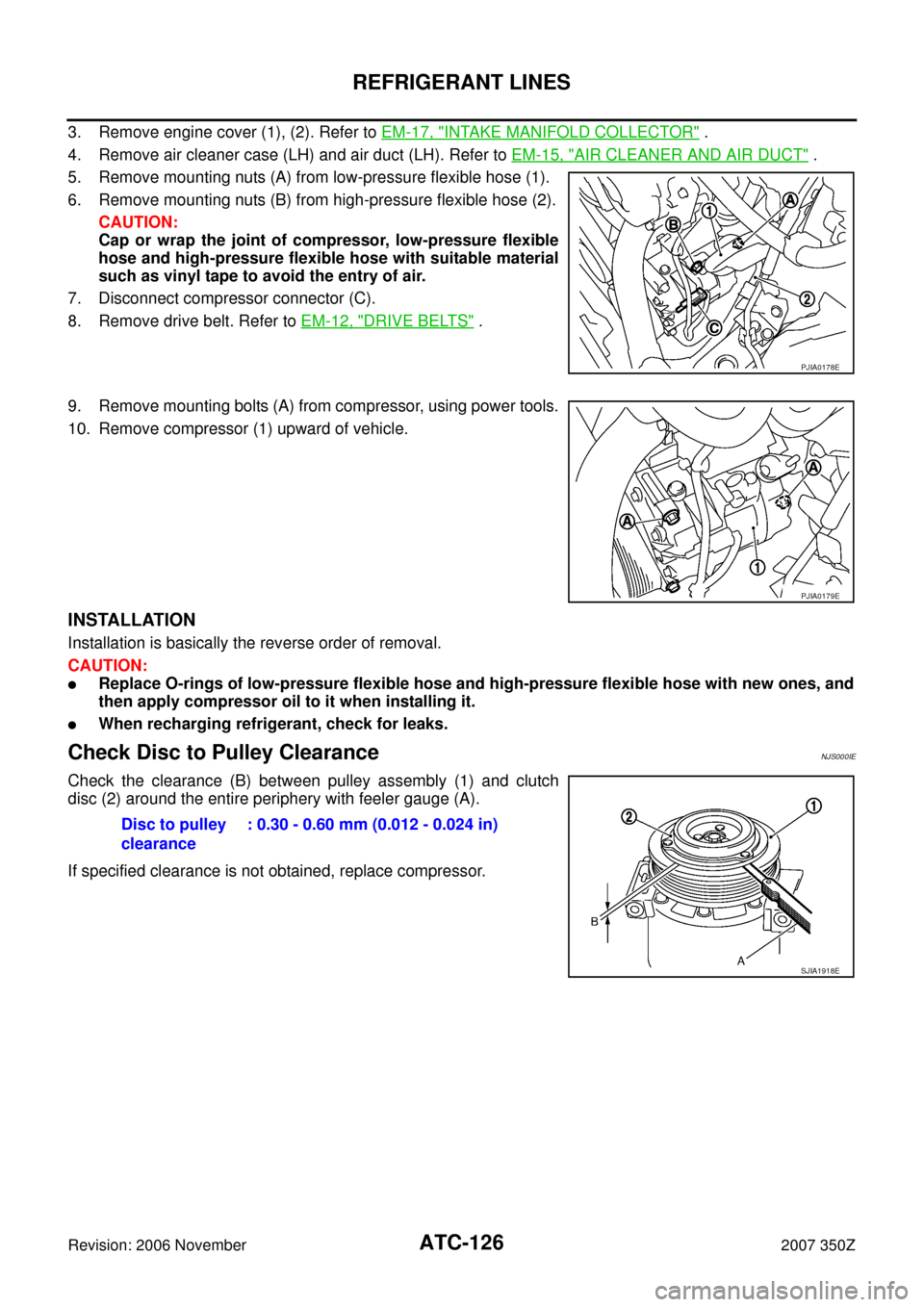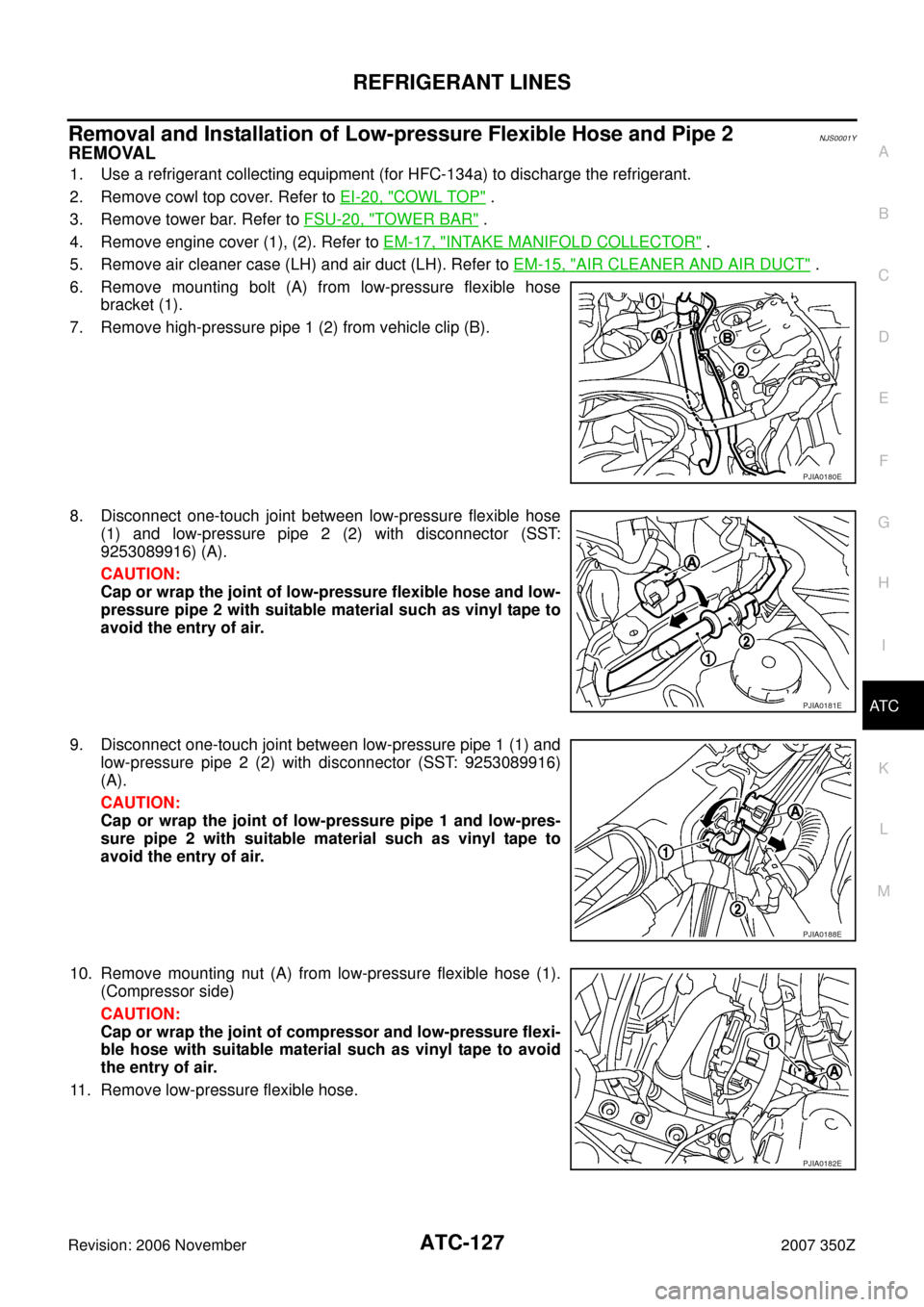Page 87 of 142

TROUBLE DIAGNOSIS
ATC-87
C
D
E
F
G
H
I
K
L
MA
B
AT C
Revision: 2006 November2007 350Z
High-pressure Side is Too Low and Low-pressure Side is Too High
Both High- and Low-pressure Sides are Too Low
Gauge indication Refrigerant cycle Probable cause Corrective action
High-pressure side is too low and
low-pressure side is too high.High- and low-pressure sides
become equal soon after com-
pressor operation stops.Compressor pressure opera-
tion is improper.
↓
Damaged inside compressor
packings.Replace compressor.
No temperature difference
between high- and low-pres-
sure sides.Compressor pressure opera-
tion is improper.
↓
Damaged inside compressor
packings.Replace compressor.
AC356A
Gauge indication Refrigerant cycle Probable cause Corrective action
Both high- and low-pressure sides
are too low.
�There is a big temperature
difference between liquid
tank outlet and inlet. Outlet
temperature is extremely
low.
�Liquid tank inlet and expan-
sion valve are frosted.Liquid tank inside is slightly
clogged.
�Replace liquid tank.
�Check lubricant for contami-
nation.
�Temperature of expansion
valve inlet is extremely low
as compared with areas
near liquid tank.
�Expansion valve inlet is
frosted.
�Temperature difference
occurs somewhere in high-
pressure side.High-pressure pipe located
between liquid tank and
expansion valve is clogged.
�Check and repair malfunc-
tioning parts.
�Check lubricant for contami-
nation.
Expansion valve and liquid
tank are warm or slightly cool
when touched.Low refrigerant charge.
↓
Leaking fittings or compo-
nents.Check refrigerant for leaks.
Refer to ATC-138, "
Checking
for Refrigerant Leaks" .
There is a big temperature dif-
ference between expansion
valve inlet and outlet while the
valve itself is frosted.Expansion valve closes a little
compared with the specifica-
tion.
↓
1. Improper expansion valve
adjustment.
2. Malfunctioning expansion
valve.
3. Outlet and inlet may be
clogged.
�Remove foreign particles by
using compressed air.
�Replace expansion valve.
�Check lubricant for contami-
nation.
An area of the low-pressure
pipe is colder than areas near
the evaporator outlet.Low-pressure pipe is clogged
or crushed.
�Check and repair malfunc-
tioning parts.
�Check lubricant for contami-
nation.
Air flow volume is not enough
or is too low.Evaporator is frozen.
�Check intake sensor circuit.
Refer to ATC-100, "
Intake
Sensor Circuit" .
�Replace compressor.
�Repair evaporator fins.
�Replace evaporator.
�Refer to AT C - 6 9 , "Blower
Motor Circuit" .
AC353A
Page 88 of 142

ATC-88
TROUBLE DIAGNOSIS
Revision: 2006 November2007 350Z
Low-pressure Side Sometimes Becomes Negative
Low-pressure Side Becomes Negative
Gauge indication Refrigerant cycle Probable cause Corrective action
Low-pressure side sometimes
becomes negative.
�Air conditioning system
does not function and does
not cyclically cool the com-
partment air.
�The system constantly func-
tions for a certain period of
time after compressor is
stopped and restarted.Refrigerant does not dis-
charge cyclically.
↓
Moisture is frozen at expan-
sion valve outlet and inlet.
↓
Water is mixed with refriger-
ant.
�Drain water from refrigerant
or replace refrigerant.
�Replace liquid tank.
AC354A
Gauge indication Refrigerant cycle Probable cause Corrective action
Low-pressure side becomes nega-
tive.
Liquid tank or front/rear side of
expansion valve’s pipe is
frosted or wet with dew.High-pressure side is closed
and refrigerant does not flow.
↓
Expansion valve or liquid tank
is frosted.Leave the system at rest until
no frost is present. Start it
again to check whether or not
the malfunction is caused by
water or foreign particles.
�If water is the cause, initially
cooling is okay. Then the
water freezes causing a
blockage. Drain water from
refrigerant or replace refrig-
erant.
�If due to foreign particles,
remove expansion valve
and remove the particles
with dry and compressed air
(not shop air).
�If either of the above meth-
ods cannot correct the mal-
function, replace expansion
valve.
�Replace liquid tank.
�Check lubricant for contami-
nation.
AC362A
Page 90 of 142
ATC-90
TROUBLE DIAGNOSIS
Revision: 2006 November2007 350Z
NoiseNJS00018
SYMPTOM: Noise
INSPECTION FLOW
*1ATC-53, "Operational Check"*2ATC-126, "Check Disc to Pulley
Clearance"
*3AT C - 2 1 , "Maintenance of Lubricant
Quantity in Compressor"
*4EM-12, "Checking Drive Belts"
SJIA0843E
Page 107 of 142

INTAKE SENSOR
ATC-107
C
D
E
F
G
H
I
K
L
MA
B
AT C
Revision: 2006 November2007 350Z
INTAKE SENSORPFP:27723
Removal and InstallationNJS0001J
REMOVAL
1. Remove low-pressure pipe 1 and high-pressure pipe 2. Refer to ATC-131, "Removal and Installation of
Low-pressure Pipe 1 and High-pressure Pipe 2" .
CAUTION:
Cap or wrap the joint of evaporator, low-pressure pipe 1, 2 and high-pressure pipe 1, 2 with suit-
able material such as vinyl tape to avoid the entry of air.
2. Slide evaporator to passenger side, and then remove intake
sensor.
INSTALLATION
Installation is basically the reverse order of removal.
CAUTION:
�Replace O-rings of low-pressure pipe 1, 2 and high-pressure pipe 1, 2 with new ones, and then
apply compressor oil to it when installing it.
�Mark the mounting position of intake sensor bracket prior to removal so that the reinstalled sen-
sor can be located in the same position.
�Female-side piping connection is thin and easy to deform. Slowly insert the male-side piping
straight in axial direction.
�Insert piping securely until a click is heard.
�After piping connection is completed, pull male-side piping by hand to make sure that connection
does not come loose.
�When recharging refrigerant, check for leaks.
RJIA1406E
Page 113 of 142

HEATER & COOLING UNIT ASSEMBLY
ATC-113
C
D
E
F
G
H
I
K
L
MA
B
AT C
Revision: 2006 November2007 350Z
12. Remove mounting bolts from heater & cooling unit assembly.
13. Remove steering column assembly mounting nuts and bolt.
14. Remove steering member mounting bolts, and then remove steering member.
15. Remove heater & cooling unit assembly.
INSTALLATION
Installation is basically the reverse order of removal.
CAUTION:
�Replace O-rings of low-pressure pipe 2 and high-pressure pipe 1 with new ones, and then apply
compressor oil to it when installing it.
�Female-side piping connection is thin and easy to deform. Slowly insert the male-side piping
straight in axial direction.
�Insert piping securely until a click is heard.
�After piping connection is completed, pull male-side piping by hand to make sure that connection
does not come loose.
�When recharging refrigerant, check for leaks.
NOTE:
�When filling radiator with coolant, refer to CO-10, "Changing Engine Coolant" .
�Recharge the refrigerant.
SJIA1221E
SJIA1222E
Heater & cooling unit assembly mounting bolts
: 6.9 N·m (0.7 kg-m, 61 in-lb)
Steering member and steering column assembly mounting nuts and bolt
: 12 N·m (1.2 kg-m, 9 ft-lb)
Page 125 of 142
REFRIGERANT LINES
ATC-125
C
D
E
F
G
H
I
K
L
MA
B
AT C
Revision: 2006 November2007 350Z
ComponentsNJS0001V
Refer to AT C - 7 , "Precautions for Refrigerant Connection" .
Removal and Installation of CompressorNJS0001W
REMOVAL
1. Use a refrigerant collecting equipment (for HFC-134a) to discharge the refrigerant.
2. Remove tower bar. Refer to FSU-20, "
TOWER BAR" .
SJIA1885E
PJIA0174E
: N·m (kg-m, ft-lb)
Page 126 of 142

ATC-126
REFRIGERANT LINES
Revision: 2006 November2007 350Z
3. Remove engine cover (1), (2). Refer to EM-17, "INTAKE MANIFOLD COLLECTOR" .
4. Remove air cleaner case (LH) and air duct (LH). Refer to EM-15, "
AIR CLEANER AND AIR DUCT" .
5. Remove mounting nuts (A) from low-pressure flexible hose (1).
6. Remove mounting nuts (B) from high-pressure flexible hose (2).
CAUTION:
Cap or wrap the joint of compressor, low-pressure flexible
hose and high-pressure flexible hose with suitable material
such as vinyl tape to avoid the entry of air.
7. Disconnect compressor connector (C).
8. Remove drive belt. Refer to EM-12, "
DRIVE BELTS" .
9. Remove mounting bolts (A) from compressor, using power tools.
10. Remove compressor (1) upward of vehicle.
INSTALLATION
Installation is basically the reverse order of removal.
CAUTION:
�Replace O-rings of low-pressure flexible hose and high-pressure flexible hose with new ones, and
then apply compressor oil to it when installing it.
�When recharging refrigerant, check for leaks.
Check Disc to Pulley ClearanceNJS000IE
Check the clearance (B) between pulley assembly (1) and clutch
disc (2) around the entire periphery with feeler gauge (A).
If specified clearance is not obtained, replace compressor.
PJIA0178E
PJIA0179E
Disc to pulley
clearance: 0.30 - 0.60 mm (0.012 - 0.024 in)
SJIA1918E
Page 127 of 142

REFRIGERANT LINES
ATC-127
C
D
E
F
G
H
I
K
L
MA
B
AT C
Revision: 2006 November2007 350Z
Removal and Installation of Low-pressure Flexible Hose and Pipe 2NJS0001Y
REMOVAL
1. Use a refrigerant collecting equipment (for HFC-134a) to discharge the refrigerant.
2. Remove cowl top cover. Refer to EI-20, "
COWL TOP" .
3. Remove tower bar. Refer to FSU-20, "
TOWER BAR" .
4. Remove engine cover (1), (2). Refer to EM-17, "
INTAKE MANIFOLD COLLECTOR" .
5. Remove air cleaner case (LH) and air duct (LH). Refer to EM-15, "
AIR CLEANER AND AIR DUCT" .
6. Remove mounting bolt (A) from low-pressure flexible hose
bracket (1).
7. Remove high-pressure pipe 1 (2) from vehicle clip (B).
8. Disconnect one-touch joint between low-pressure flexible hose
(1) and low-pressure pipe 2 (2) with disconnector (SST:
9253089916) (A).
CAUTION:
Cap or wrap the joint of low-pressure flexible hose and low-
pressure pipe 2 with suitable material such as vinyl tape to
avoid the entry of air.
9. Disconnect one-touch joint between low-pressure pipe 1 (1) and
low-pressure pipe 2 (2) with disconnector (SST: 9253089916)
(A).
CAUTION:
Cap or wrap the joint of low-pressure pipe 1 and low-pres-
sure pipe 2 with suitable material such as vinyl tape to
avoid the entry of air.
10. Remove mounting nut (A) from low-pressure flexible hose (1).
(Compressor side)
CAUTION:
Cap or wrap the joint of compressor and low-pressure flexi-
ble hose with suitable material such as vinyl tape to avoid
the entry of air.
11. Remove low-pressure flexible hose.
PJIA0180E
PJIA0181E
PJIA0188E
PJIA0182E